
One of the best things about cycling is that you get to spend quality time outdoors. Cycling is fantastic exercise and recreation, but spending long hours under the sun can cause harm. Protecting yourself from harmful ultraviolet (UV) rays is crucial to avoid sunburns and skin damage and reduce the risk of skin cancer.
Table of Contents
One of the primary strategies for sun protection is choosing the appropriate gear and clothing to shield your skin from the sun’s rays. Planning your rides during low-UV hours, such as early mornings or late evenings, will not only make your rides more comfortable but it will also help minimize the sun’s harmful rays.
In addition to wearing protective gear, cyclists should also apply a high-quality sunscreen and understand the UPF ratings of their clothing to ensure the best possible sun protection. UPF ratings range from 15 to 50 and represent the ratio of the garment’s UV radiation blocking capability.

Understanding Sun Protection Basics
Role of Sunscreen
Sunscreen plays a crucial role in protecting cyclists from the harmful effects of sun exposure, such as sunburn and skin cancer. When selecting a sunscreen, it is essential to look for a broad-spectrum sunscreen that offers protection against both UVA and UVB rays. An SPF 30 or higher is recommended for adequate protection. Cyclists should opt for water-resistant sunscreens, as they are more likely to withstand sweat and provide lasting protection during a ride. Sunscreen ingredients such as oxybenzone, zinc oxide, and titanium dioxide play different roles in sun protection; while oxybenzone absorbs UV rays, zinc oxide and titanium dioxide act as physical blockers, reflecting the sun’s rays away from the skin.
Ultraviolet Protection Factor (UPF) Clothing
In addition to sunscreen, UPF clothing offers excellent protection, especially for cyclists. UPF measures the amount of UV radiation that penetrates through a fabric, with higher UPF ratings indicating better protection. Wearing UPF clothing, such as a hat or cap, reduces the amount of sunlight exposure on a your skin, further lowering the risks of a burnt scalp.
Essential UPF clothing items that we regularly wear:
- UPF 30+ cycling jersey
- UPF 30+ cycling shorts
- UPF 30+ arm sleeves
- UPF 30+ leg sleeves
- UPF 30+ cycling cap or hat
Effective eBike Clothing for UV Protection
Selecting Fabrics and Colors with UPF
When it comes to sun protection, the choice of fabric and its color plays a crucial role. UPF (Ultraviolet Protection Factor) ratings range from 15 to over 50+ and represent a garment’s ability to block UV radiation. For instance, a UPF value of 25 indicates that only 1 “unit” of UV radiation is let in for every 24 the fabric block. While 50 blocks 98% only letting in 2% of harmful rays.
Fabrics such as lycra, polyester, cotton, and wool all have advantages and disadvantages regarding sun protection. Lycra and polyester are popular for cycling jerseys, as they offer excellent stretch, allowing the material to fit comfortably while providing a UPF 50+ rating. A cotton T-shirt has a UPF of 5 and is better left at home.
In terms of color selection, lighter colors like white and blue typically offer a lower UPF rating compared to darker colors, as they reflect more sunlight. However, the specific construction and treatment of fabrics can influence their UPF rating, so it’s essential to check the label for each garment’s actual rating.

UPF and Summer Cycling Jerseys
Summer cycling jerseys are designed for maximum ventilation and comfort while offering adequate sun protection. These jerseys often use lightweight, breathable materials like polyester or lycra, which help wick moisture away from the body, keeping cyclists cool and dry during intense rides.
Many hot weather jerseys also feature UPF-rated fabric to protect the rider from harmful UV rays. One example of such a brand is Rapha, which specifically designs jerseys with UPF-rated materials for sun protection. Additionally, long-sleeve jerseys, arm sleeves, and leg sleeves with UPF protection can be worn to provide added coverage and reduce sun exposure.
It’s essential for cyclists to invest in appropriate sun-protective clothing, taking into consideration the fabric, UPF rating, and color, to ensure the utmost protection during their outdoor rides.
Summer Cycling Caps, Visors, and Hats
Cycling caps, visors, and hats provide essential sun protection for cyclists, helping to shield their face and eyes from harmful UV rays. These accessories come in various styles and materials, ensuring a comfortable fit and effective sun protection for everyone.
Cycling Caps
Cycling caps are traditionally made of lightweight, breathable materials to provide comfort during long rides. They are specifically designed to fit under a helmet, offering sun protection and acting as a sweatband. Assos offers a popular cycling cap that combines breathability with rain, wind, and sun protection. It is made of polyester and cotton, providing a comfortable fit.
Visors
Visors are a great option for those who prefer a more minimalistic approach to sun protection. They are usually attached to the front of a helmet, shading the eyes without covering the head entirely. My wife likes a visor, as they allow more airflow around her head, preventing overheating.
Hat Styles
There are several types of hats suitable for cyclists, each providing differing degrees of sun protection:
- Baseball caps: These are a popular choice for casual, short-distance cycling. They offer some sun protection for the face, but may not be the most comfortable option for long-distance rides.
- Wide-brimmed hats: While not specifically tailored for cycling, wide-brimmed hats can provide extensive sun protection for the face, neck, and ears. This is what my daughter wears and they can be worn under or over a helmet for those cyclists who prioritize sun protection above all else.
Materials and Sun Protection Factors
Cycling caps, visors, and hats are made from various materials, each offering unique benefits in terms of fit and sun protection. Light colors and tightly woven fabrics are ideal for reducing the sun’s impact. Some materials, like those used in GripGrab’s summer cap, feature breathable mesh and UV protection, making them well-suited for hot weather riding.
When choosing a cap, visor, or hat for cycling, it’s crucial to consider how it will fit with a helmet and the level of sun protection needed. Cycling caps are a popular option for their compatibility with helmets and their ability to provide both sun protection and sweat absorption.
The Role of Smart Decisions 🌞
Putting on sunscreen is just the beginning of an effective strategy. (There is a lot to learn about the sun and its impacts.) You should also wear protective clothing as much as possible, including hats, long sleeve shirts, and long pants within reason.
Deciding on which hours you spend on your bike can also play a role. Whenever possible, stay away from the sun at its most intense, usually between the hours of 10 a.m. to 2 p.m. Choose to bike early in the morning or later in the evening, both wonderful times to be out. You should also be aware of any special risk factors you have, such as pale skin or red or light-colored hair. Finally, if you take any medications just be aware that some medicines increase sun sensitivity.
Quality in Sun Gear and Protective Clothing
The cycling world is changing continuously with advancements in technology and gear. Sun-protection clothing is now available to add an extra layer of protection to your rides. You can find lightweight and appealing options that won’t feel uncomfortable against your skin but will they last?
Sun Gear 2023 Checklist:
- Buy from reputable brands that stand behind their products like LL Bean, REI, Terry, Specilaized, and Backcountry. Cheap gear on Amazon may last half a season or as we have often tested won’t.
- Get a tight weave
- Synthetic is better for Sun
- Loose is better than tight
- Colors matter with dark being better: Black, Brown, and Red being best
Do I need Sunglasses when I cycle?
Sunglasses are essential for cyclists. They not only look cool but also provide safety benefits. As you speed on your bike, clear vision is crucial. Quality sunglasses help you navigate light changes and spot obstacles on the road. Good sunglasses have saved many riders from getting road rash.
As you ride you will encounter many different light conditions. Some of these increase the level of sunlight reaching your eyes, elevating your risk, over time, of eye complications. The glare off water, snow, sand, and bright objects all have an impact. Lack of eye protection can result in the early onset of cataracts in some people.
- Pick glasses with a UV400 rating as these block out 99% of UVA and UVB radiation
- Do not assume dark-tinted glasses offer better protection than those with lighter tints
- Look into wraparound styles that offer more protection around the outer edges of the eye
- Don’t fixate on price as more expensive glasses are not always better for UV protection! We like Goodr for great $20-$30 sunglasses vs $300 Ray-Bans that we keep losing.
If riding with children, make sure they wear sunglasses with adequate UV protection. Early safeguards for young eyes are important. Finally, a hat with a brim can help shield eyes from sunlight in addition to quality sunglasses. Top brands of sunglasses for cyclists include Oakley, Tifosi Crit, 100%, Rapha Pro Team, and Salice, or I just wear my cheap Goodr sunglasses as I’m always losing them.
Final Step for Sun Protection – Planning
At this point, you might feel you are definitely protected from even a speck of sun falling on your sensitive skin. That once you have put on sunscreen, donned your sunglasses, and pulled on long sleeves and long pants with a UPF 50 rating, you are more or less invincible. Not true 🙂
Plan your ride. Maybe stop for lunch while the sun is at its peak? Take that forest trail on the ride home. Use the shadows of tall buildings to keep you cool in the city sun. A small bit of looking at Google Maps can be a big help in keeping you cool and out of the sun this summer. Enjoy the ride!

Cycling Sun Protection FAQ’s
One common question among cyclists is how to protect their skin from the sun while riding. There are several effective methods to ensure adequate sun protection.
What type of clothing provides sun protection while cycling? Wearing UPF-rated clothing can help protect your skin from harmful UV radiation. UPF ratings range from 15 to over 50, with higher ratings offering greater protection. Garments with a UPF 25 rating, for example, let in one “unit” of UV radiation for every 24 it blocks. Investing in UPF clothing can significantly reduce your risk of sunburn and skin damage.
Are there any accessories that can enhance sun protection while cycling? Yes, accessories like hats, sunglasses, and sun sleeves can provide additional protection. Hats or cycling caps with a peak can help shield your face from the sun, while UV sunglasses protect your eyes. Sun sleeves made by cycling apparel companies are designed for the riding position and have silicone grippers to prevent slipping, like the Pearl Izumi Sun Sleeves.
What time of day is the sun most intense for cyclists? The sun is usually most intense between 10 a.m. and 2 p.m. Biking early in the morning or later in the evening is recommended to avoid the strongest UV rays.
How can cyclists use sunscreen effectively? When choosing a sunscreen, make sure it offers broad-spectrum protection with an SPF of 30 or higher. Apply it generously to all exposed skin, and don’t forget commonly overlooked areas like the back of your neck and your ears. Reapply every two hours or after sweating, as sweat may decrease the sunscreen’s effectiveness.
